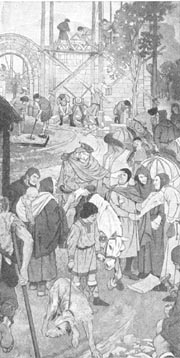St. David of Scotland
The following account to the life of St. David, King David
(I) of Scotland is quoted from Thurston and Attwater: Butlerís
Lives of the Saints, Thomas More Publishing, Allen, Texas (1956),
pg. 383 Ė384.

"The name of this king occurs in several
old Scottish calendars and more than one modern Catholic church is dedicated
in his honour; he belongs to the category of popularly canonized national
heroes, the particulars of whose life belong mainly to secular history.
He was born about 1080, the youngest of the six sons of King Malcolm Cænmore
and his queen, St Margaret. In 1093 he was sent to the Norman court in
England, where he remained for some years. When his brother Alexander succeeded
to the Scottish throne in 1107, David became prince of Cumbria (roughly
the Lowlands), and by his marriage in 1113 to Matilda, widow of the earl
of Northampton, he became earl of Huntingdon. In 1124 he succeeded his
brother as King David I.
"St Ælred of Rievaulx was in
his earlier years master of the household to David with whom he kept up
a close friendship, and after the kingís death he wrote an account of him.
In it he speaks of Davidís reluctance to accept the crown, of the justice
of his rule, of his almsdeeds and his accessibility to all, of his efforts
to maintain concord among the clergy, of his personal piety, and in general
of the great work he did for the consolidation of the kingdom of Scotland.
Ælredís only criticism was of his failure to control the savagery
and rapacity of his troops when he invaded England, on behalf of his niece
Matilda against Stephen. For this David was very contrite, and is said
to have looked on his defeat at the Battle of the Standard and elsewhere
and the early death of his only son as just retribution therefor.
"It was afterwards complained that
King Davidís benefactions to the Church impoverished the crown, among the
critics being his fifteenth-century successor, James I. For not only did
he found the royal burghs of Edinburgh, Berwick, Roxburgh, Stirling and
perhaps Perth, but he also established the bishoprics of Brechin, Dunblane,
Caithness, Ross and Aberdeen and founded numerous monasteries. Among them
were the Cistercian houses of Melrose, Kinloss, Newbattle and Dundrennan,
and Holyrood itself for Augustinian canons.
"St Ælred gives a circumstantial
account of Davidís death at Carlisle on May 24, 1153. On the Friday he
was anointed and given viaticum, and then spent much time in praying psalms
with his attendants. On Saturday they urged him to rest, but he replied,
ďLet me rather think about the things of God, so that my spirit may set
out strengthened on its journey from exile to home. When I stand before
Godís tremendous judgement-seat you will not be able to answer for me or
defend me; no one will be able to deliver me from His handĒ. And so he
continued to pray; and at dawn of Sunday he passed away peacefully as if
he slept.
"St David had helped to endow Dunfermline
Abbey, founded by his father and mother, and he had peopled it with Benedictine
monks from Canterbury. There he was buried, and at his shrine his memory
was venerated until the Reformation."
St. David's feast day is May 24, the
anniversary of his death.
Click here to return to the Kings
of Scotland Page.
